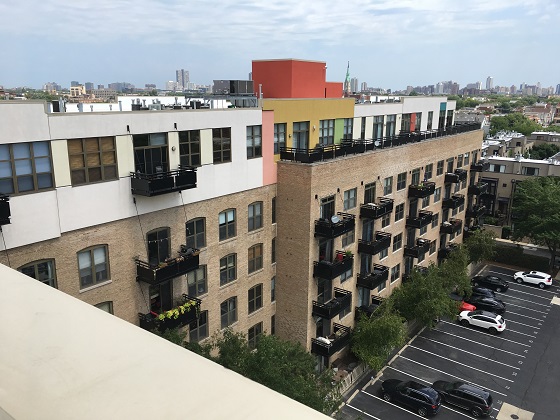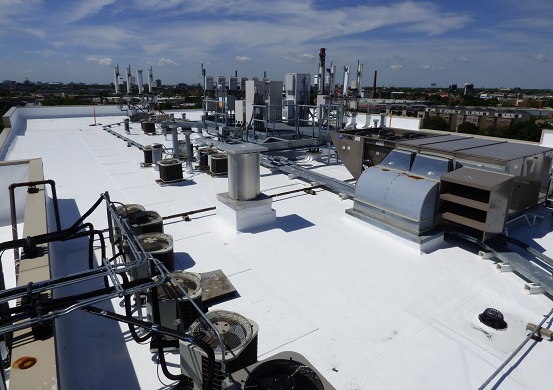Formerly a warehouse district near Chicago’s Lincoln Park, the small neighborhood of Lathrop is now a residential and commercial development with both shopping centers and schools, as well as coffee shops and even a few eateries. Regal Lofts, a 107-unit condo building constructed in 2000 on Diversey Parkway, is one of many residential structures in the area.
By 2018, after 18 years of enduring the harsh elements of Illinois weather — including strong wind, heavy rain, and hot sun — the Regal Lofts building needed maintenance. As a result, the owners hired Hammerbrush Painting and Construction to paint the exterior. The building’s roof was also nearing the end of its useful life. It was time for either a roof tear-off or a coating job fit for a king.
Hammerbrush knew who to call: GreenPROChicago, with whom they had worked on a previous roof recoating project (see “Windy City Condos Restored With White Silicone Roof”). “As a painting contractor, Hammerbrush is a Sherwin-Williams customer,” said Dave Welte, president of roof coatings contractor GreenPROChicago. “Because Hammerbrush is not certified to do the coating application, Sherwin-Williams introduced us as certified applicators, and we were subcontracted.”
Regal Lofts is a six-story, L-shaped building with more than 30,000 square feet (2,787.1 m²) of roof area. On the longer leg of the L, some of the sixth-floor condos have wooden decking extending out over the lower part of the roof, with a cavernous space under the deck — a challenge in the crew’s near future.
Nooks, Crannies, and Penetrations
The roof substrate was granulated cap sheet, worn thin from years of enduring Chicago’s temperamental weather. There were no leaks or cracks visible, but ponding water and sunlight had started to eat away at the cap sheet. Welte spoke from experience when he said, “When you recoat, you’re buying protection on the roof for 15 years before you get back to the substrate.”
With two primary workers on the job, plus two or three assistants brought in when needed, the work began June 15, 2018. The first step was power washing the roof to remove any debris, which the crew did by using a Mi-T-M 300-psi (2,068.4 kPa) power washer. “This step took about a full week,” said Welte. “We also had to power wash under the wooden decking. The hatch under the deck ranged in height from nearly 6 feet [1.8 m] down to about 1 foot [0.3 m]. This was certainly a challenge to access in terms of completing the power washing.”
Crew members wore suitable personal protective equipment (PPE) throughout the entire job, including rubber gloves and safety glasses. The use of safety harnesses was imperative. For work within 6 feet (1.8 m) of the roof’s edge, workers wore fall protection harnesses from Guardian with 50-foot (15.2 m) ropes.
The project utilized the Sherwin-Williams’ UNIFLEX Fluid Applied Roofing System, which started with One Flash Permanent Roof Repair Sealant. The material was applied using throwaway paint brushes because of how sticky the material is. In the cavern-like area under the wooden deck, the workers had to lie on their stomachs to apply the coating system.

But the roof also had approximately 200 penetrations, including air conditioning (AC) units, radio antennas, and other telecommunications anchors. The penetrations were the biggest challenge of the job, according to Welte. “GreenPROChicago spent most of the time doing hand work to prep the surface and apply sealant around the numerous penetrations,” he said. “In the mornings, if the weather was clear and dry, the workers would prep and coat around the penetrations. It took a couple weeks to do this part. This was the most hand work we had done in 10 years.”
Carrying the Load
Another challenge was getting materials up to the roof. Welte described the scenario: “The sixth floor is reached by a stairwell that goes up from the last elevator position. All materials were brought up to the roof in buckets. They were brought up by the elevator and then carried up the stairs. We carried approximately 30 2-gallon [7.6 L] buckets of sealant and 95 5-gallon [18.9 L] buckets of silicone coating, plus other patching materials, to the roof.”
Once the penetrations were sealed, the rest of the roof was a standard application. Rubberized Silicone Roof Coating 44-300 White was the main component. All the gray areas where the sealant had been applied were coated first. Then the seams were double-coated with the White 44 system. Finally, a full silicone coating was applied to the entire roof. As the material was poured out, the crew used squeegees to move it around to the appropriate thickness, and then it was back rolled using 18-inch rollers. The total system was applied to an average of 48 mils (1,219.2 microns) wet film thickness, which converted to an average of 44 mils (1,117.6 microns) dry film thickness, to meet the requirements for Sherwin-Williams’ UNIGUARD 15-year warranty for a granulated modified roof system. According to Welte, the system cures enough to withstand a rainstorm within 6 hours and enough to walk on it within 24 hours.
Besides the challenge of the penetrations in the roof, there were also rain and wind issues. The roof had to be dry for any work to be done. In addition, each edge had a parapet wall that needed to remain clean. “When applying double layers of the coating,” Welte said, “you had to have a calm day or the coating would go all over the parapet walls or other parts of the building. We had to do our work slowly and deliberately, close to the surface to be coated. Some coating still did get on other areas because of the wind, and we had to clean it up afterward with mineral spirits and scrubbing pads.”
One additional item of equipment used for the project was a ladder. Crew members used this to get on top of the small communications room on the roof, as well as to get access below the wooden decks. “We couldn’t go through people’s condos, so we had to use ladders to get up and down in these areas,” Welte said.
“Weather” to Recoat
When Welte was asked why customers choose to recoat their roofs, he explained, “Costs keep escalating to redo a roof. Building owners who are looking to extend the life of their roof will use a system like UNIFLEX from Sherwin-Williams. First, a re-roof would have been a nightmare for this client with all those penetrations. Second, coatings are about one-third or less the cost of a roof tear-off and have less environmental impact. Tenants don’t have to deal with the disruption. Plus, a white roof reduces the heat exchange between the roof and the tenant below. That is far less taxing on the HVAC [heating, ventilation, and air conditioning] system overall.”
The project was completed in the middle of August, for a total timeline of eight weeks. The coating system, which is based on time and materials, resulted in a stunning, silicone-coated roof that is warranted for 15 years. That’s a regal treatment for a roof in any neighborhood!
